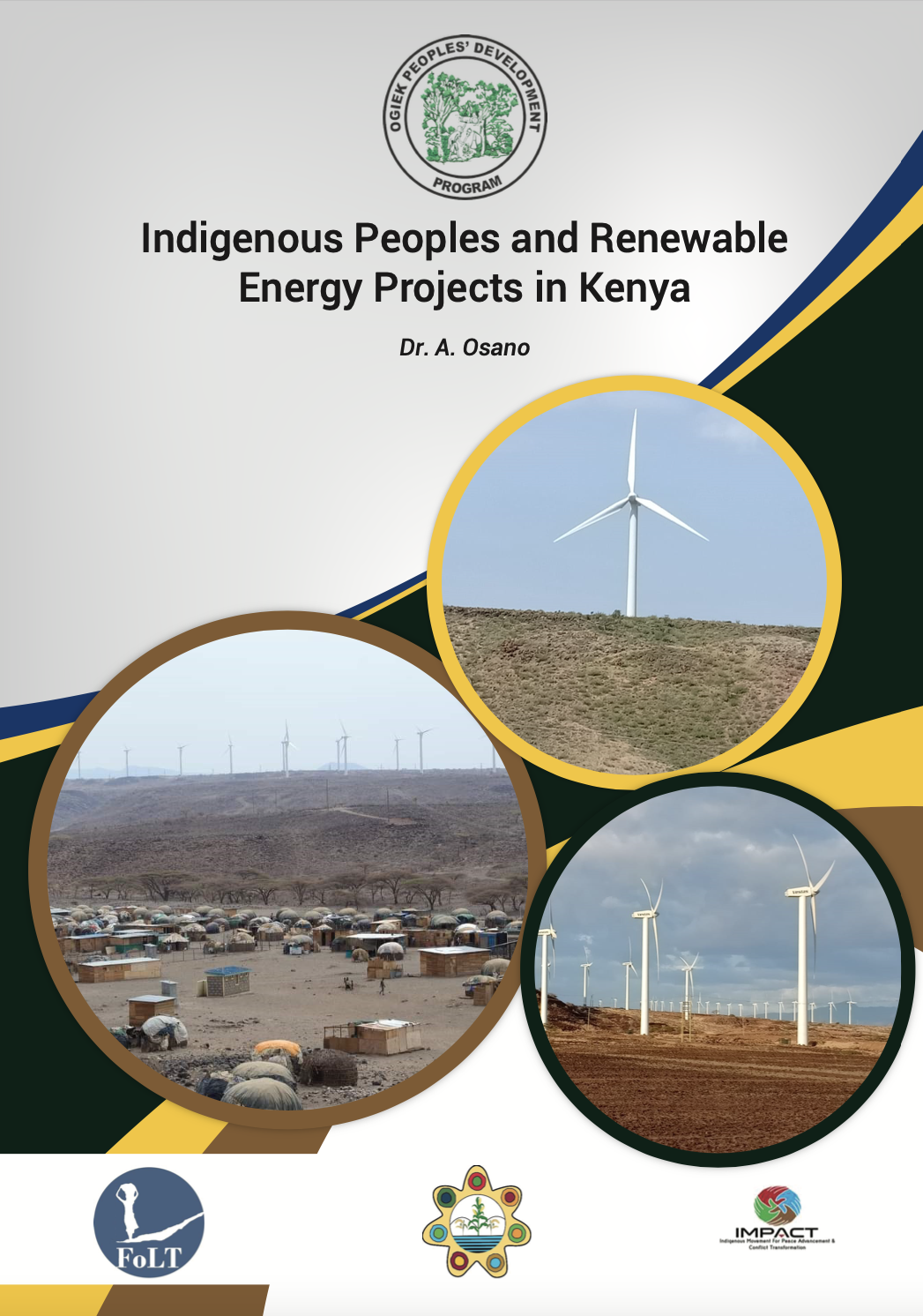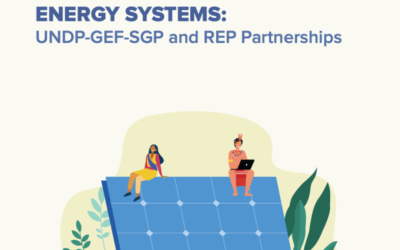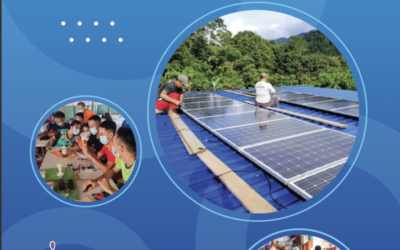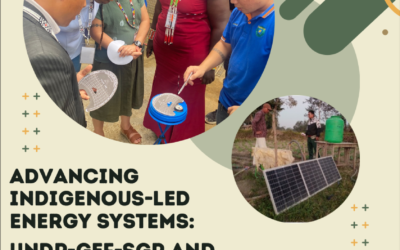Ogiek Peoples’ Development Program (OPDP) launches the report: Indigenous Peoples and Renewable Energy Projects in Kenya.
OPDP is one of the partners of Indigenous Peoples Major Group on its Right Energy Partnership initiative in Kenya.
Here’s the Executive Summary of the report:
There is greater need for clean energy as Kenya fosters towards Vision 2030. Energy is both an enabler and driver of the vision. Sustainable Development Goal (SDG) number 7 insists on clean energy use. Use of renewable energies seeks to increase energy for development while eliminating CO2 from the atmosphere thus creating a clean environment for humanity to live in. Fossil-based fuels emit a lot of gaseous emissions when combusted leading to climate changes which have far-reaching effects to people and their environment. More attention has thus been shifted to renewable energies which are environment friendly. This report seeks to identify, strategize and advocate for a win-win formula for all parties. The report maps out Renewable Energy Projects (REPs) in Indigenous Peoples (IPs) territories and performs a detailed review on the situational analysis of existing laws, policies and institutional frameworks of key REP players. The report also strategizes for advocacy policies towards IPs adequate compensation of wealth, livelihoods, cultures and human rights recognition if moved out of their ancestral lands to pave way for REPs.
1.0 Renewable Energy Projects (REPs) in Kenya come both as a blessing and curse in disguise. An uproar towards establishment of REPs resulted from several energy reforms in the late 1990s and 2000s. The Feed-in Tariff (FiT) of March, 2008 allowed independent power producers (IPPs) to generate and directly inject power into the national grid at negotiable Power Purchasing Agreements (PPAs). Further energy reforms liberated the energy market attracting many renewable energy investors from within and outside the country. The scramble towards investing in the ‘virgin field’ in Kenya was not only for the good of Kenyans but also for the financial satisfaction of the renewable energy ‘donors’. Consequently, powerful financial institutions scrambled forIPs’ lands which were the potential hotspots of this new resource. Momentarily, human rights and dignity were forgotten as the government watched silently in confusion. The plight of IPs was compounded by their incapacity to fight back. From the forceful evictions of the Ewuaso o Nkidong’i clan in Olkaria to the witty displacement of the Sarima villagers of Loiyangalani in Lake Turkana, the tales of IPs were similar.
2.0 Despite having numerous policies on energy, land and human rights, up to date there is no single unified definition of IPs. The Kenyan constitution of 2010 does not directly acknowledge of their existence! They are generalized as marginalized communities. This perspective has enabled REPs practitioners to overlook IPs and their rights. The REPs have specialized in tactics that support their ill motifs against IPs even with clear human rights, land and energy policies. Any policy, act or convention that supports their intentions is largely magnified while that which supports IPs rights is de-magnified. Even the institution frameworks in the energy value chain in Kenya appear to read from the same script with REPs. Free, Prior and Informed Consent (FPIC) documents, Environmental and Social Impact Assessment (ESIA) reports, Environmental Impact Assessment (EIA) reports, compensation and benefits-sharing policies and Resettlement Action Plan (RAP) documents which are intended to protect vulnerable IPs from such projects are coined to do the exact opposite.
3.0 The fidelity of any REP in fulfilling its human rights commitments lie on its key players. Most energy institutions and REPs have well-structured policies to guide them on human rights. Unfortunately, these policies are only documented and used for formality purposes. The situation is worsened by the reality of minimal knowledge of these policies, principles and safeguards standards amongst the intended beneficiaries. Due to the wide scope of players involved in REPs, it is difficult to control their individual human rights commitments. Most of the REPs have clear human rights commitments guided by Environment and Social Governance (ESG) policies, International Finance Corporation (IFC) policies, World Bank Guiding Principles amongst other strong documents that seek to leverage for human rights of IPs. Unfortunately, the practicability of these policies is yet to be seen. The only instance this was observed was in 2012 when World Bank withdrew from Lake Turkana Wind Power Project due to the unfair PPA signed with Kenya Power. The deal was unfair to Kenyans and Kenya Power turned a blind eye to this. World Bank tried to leverage for Kenya Power to negotiate for friendlier cost of power in vain. Despite there being evident uncontrolled pollution from geothermal drilling in Olkaria, the REPs still have a clean bill of rights on the same.
4.0 The solution to challenges faced by IPs is fully bestowed upon them. They must acknowledge of having the problem and highlight their weaknesses that should be addressed to solve the problem. IPs should be more liberal to embrace the contemporary education system, vocational training and state laws. They should put more efforts in teaming up, pooling resources together and benchmark with other successful IPs in other countries who overcame this plight. This report identifies the key challenges faced by IPs in the context of REPs, offers best management practices and key players to be used against the challenges before highlighting a Strategic Advocacy Action Plan (SAAP). The plan draws its fabric from existing policy documents (FPIC, ESIA, EIA and RAP reports, compensation and benefits-sharing policies). The plan has 3 pillars of: legal frameworks, fiscal policies and social IPs-REPs community schemes at pre-feasibility, initiation and operation stages of REPs all benchmarked from successful IPs in other countries. In the legal framework, the document proposes due recognition of IPs and their customary systems (land tenure, education, and culture) in the constitution so that they can be adequately compensated during resettlement. Legal documents used during resettlement should be reformatted and availed in IPs languages and adequate consultation time allowed. For fiscal analysis, the report recommends more networking between IP communities from within the country and externally. This will enable them to pool resources, monetize them and use them for investment purposes. Monetary value should also be attached to their IP economic activities and cultures for easier compensation plans. Socio community schemes are intended to bridge the rift between IPs and REPs. a Sustainable Value Framework (SVF) for restructuring IPs territories and resources is also proposed. The framework has given more weight to culture and environmental impact vis-à-vis REPs profits as is the current norm.
Source: Ogiek Peoples
Download the report here: https://bit.ly/3f51bvr





0 Comments